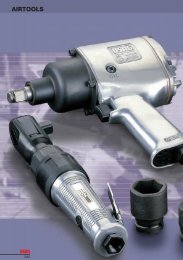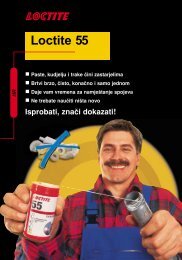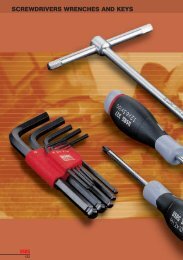Industrial seal self study guide - SKF.com
Industrial seal self study guide - SKF.com
Industrial seal self study guide - SKF.com
Create successful ePaper yourself
Turn your PDF publications into a flip-book with our unique Google optimized e-Paper software.
Seal Selection (cont.)<br />
l<br />
A<br />
B<br />
Seal Selection Criteria<br />
Factors to consider when selecting a <strong>seal</strong> for a particular application<br />
(fig. 5c) include:<br />
H<br />
F<br />
A variety of factors determine<br />
proper <strong>seal</strong> selection (fig. 5c).<br />
E<br />
G<br />
D<br />
C<br />
• Basic <strong>seal</strong> function<br />
• Shaft surface finish (A)<br />
• Shaft speed and direction (G)<br />
• Shaft and bore conditions (B)<br />
• Shaft eccentricity (E)<br />
• Seal material/lubricant <strong>com</strong>patibility<br />
• Underlip temperature (F)<br />
• Contaminants (abrasiveness) (C)<br />
• Pressure (internal/external) (I)<br />
PERCENT FAILURE<br />
100<br />
90<br />
80<br />
70<br />
60<br />
50<br />
40<br />
30<br />
20<br />
10<br />
(fig. 5d)<br />
DUAL LIP<br />
SEAL<br />
SINGLE LIP<br />
SEAL<br />
RELATIVE TIME TO FAILURE<br />
In many applications, <strong>seal</strong> life can be extended simply by substituting<br />
the same size <strong>seal</strong> (O.D. and I.D.), but of slightly different design or with<br />
a different lip material. A narrower <strong>seal</strong> width can usually be used (see<br />
following “Seal Width vs. Seal Performance” section). The <strong>seal</strong> selected<br />
must be able to meet the application’s requirements for operating<br />
temperature, pressure, and other factors listed above.<br />
Single Lip vs. Double Lip Seals Test Results<br />
In its development of new <strong>seal</strong> designs, <strong>SKF</strong> has conducted extensive<br />
testing. One series of tests has <strong>com</strong>pared single lip with double lip<br />
<strong>seal</strong>s (fig. 5d). Test objectives were to determine:<br />
• Does the double lip <strong>seal</strong>’s secondary (dust) lip help or hinder<br />
the primary lip?<br />
• How does the double lip <strong>seal</strong>’s overall performance <strong>com</strong>pare<br />
with that of the single lip <strong>seal</strong>?<br />
During testing, these measurements were taken:<br />
Test results:<br />
• Temperature vs. shaft speed.<br />
• Dust ingestion vs. time.<br />
• Peak performance vs. temperature rise.<br />
• The double lip <strong>seal</strong> failed at 270 hours.<br />
• The single lip <strong>seal</strong>, tested under identical conditions, was still<br />
running at 1254 hours.<br />
• The single lip <strong>seal</strong> was proven to run four times longer than<br />
the double lip <strong>seal</strong>.<br />
48<br />
• The single lip <strong>seal</strong> runs cooler.







